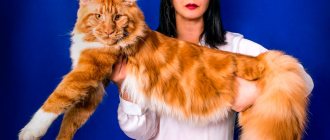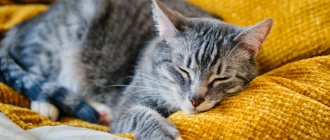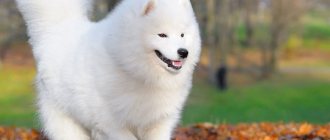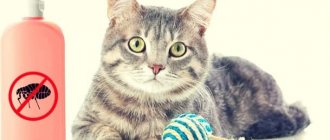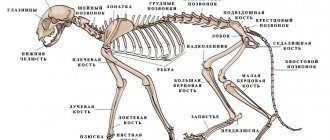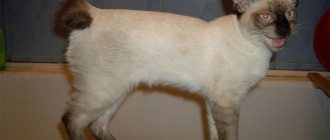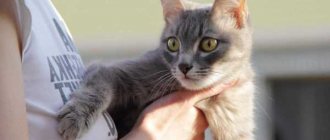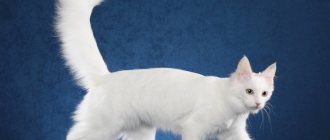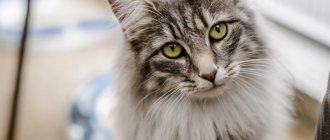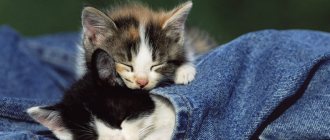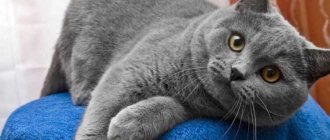All representatives of the feline species, just like humans, have ancestors named by researchers neophelides And paleofelids. Neophelids represent the forerunner of all cat species. Paleophelides is a side branch that included the most ancient saber-toothed animals, as well as nimravines.
Research by scientists has shown that these amazing creatures, from which modern cats trace their ancestry, inhabited our planet approximately 25 million years ago. It still remains a mystery what caused the disappearance of the paleofelids from the face of the earth. This may have occurred as a result of changing climatic conditions.
Let's consider all the descendants of the neophelides, who, according to scientists, inhabited the earth during different periods of the development of life on the planet.
The most ancient of them is considered to be a medium-sized (something between an ordinary modern cat and a cheetah) predatory animal that obtained its food by hunting. This is the so-called Pseudaelurus, which existed approximately 20 million years ago.
The next stage in the development of representatives of this family was the emergence of two more varieties. A typical representative of the former was the saber-toothed tiger, an animal of enormous size, clumsy, but predatory and dangerous. The prey of the saber-toothed tiger, as a rule, were herbivores. This animal is notable for its sharp and very long fangs.
Findings discovered by researchers suggest that the length of the fangs of these neophelide descendants could reach 20 cm or more. Modern man has the opportunity to quite clearly imagine the appearance of a saber-toothed tiger thanks to numerous engravings and illustrations. The terrifying fangs were visible even if their owner closed his mouth.
These contemporaries of the Ice Age, who lived at the same time as huge animals that fed on plant foods, became extinct approximately 10 million years ago. Animals of another group became the ancestors of modern pets and other small energetic animals of this species that inhabit our planet in abundance. Neophelids were the ancestors of huge animals, similar in size to modern tigers or lions. These prehistoric cats became extinct relatively recently - about one million years ago.
Ancestors
All modern predators descended from miacids - nimble animals similar to stoats.
Evolution divided them into two “camps” 40 million years ago. The first group is the ancestors of the canids: walruses, mustelids, bears and other representatives of this suborder. The second group is the ancestors of the feliform suborder. Primarily civets, linsangs, civets, genets, and mongooses. Of the caniforms, they are more similar to martens, minks, and weasels. Together, these are small animals with an elongated body, reminiscent of those very miacids.
The common domestic cat acquired its appearance 30 million years ago. Then saber-toothed, small and large cats evolved from Pseudelurus. Sabretooths became extinct; two other subfamilies evolved into modern felines.
Their main feature is genetic perfection. An ignorant person is unlikely to recognize seals, bears and wolves as close relatives. The tiger, leopard, serval and steppe cat have much more in common.
The name comes from the Latin “catus”, formed by the verb “captat”, which means “to catch”. It replaced the ancient Latin word “felis” - a good sign. The domestic cat as a subspecies is called Felis silvestris (forest) catus - a good (useful) forest cat that catches prey.
First meeting
The only ancestor of the domestic cat is the wild steppe or spotted cat. Today it lives in Africa, Asia, India, and the Caucasus. In Russia it is found in the Arkhangelsk region. Domestication began about 10,000 years ago, but it is quite difficult to distinguish the common domestic cat from its wild spotted relative.
Once on the lands of the Fertile Crescent, the nomadic peoples began to lead a sedentary lifestyle. At that time, people were accompanied by dogs, goats and sheep. People were familiar with small predators, but they were of no interest to each other. Birds have not yet been domesticated; wild cats have not harmed the farm. As prey, they are small, the meat is tough, and the skins are thin. No mutual claims.
It is widely believed that the mustachioed mouser became more loyal to humans as agriculture developed. Steppe cats hunted near barns full of grain and rodents. People did not object, appreciating the benefits of such a neighborhood. Seeing that the bipeds did not pose a danger, the cats treated them more and more calmly.
Recent studies show that sedentary tribes fed agile hunters long before the cultivation of cereals began. The Fertile Crescent was swarming with snakes, including poisonous ones. The cat is the only predator that kills them at any meeting, regardless of the degree of satiety.
When and how did a person domesticate a cat?
The history of the rapprochement between cats and people is quite complicated. Researchers are still debating who tamed whom first: man's cat, or man's cat?
According to one version, cats were domesticated thanks to the initiative of the inhabitants of the Middle East. Ancient people only learned to cultivate the land, as a result of which it became necessary to protect the crops from hungry rodents. To ensure the safety of food supplies, they cunningly lured the cat and adapted it to their needs.
Another version looks no less plausible. It is likely that ancient cats were able to “domesticate” on their own. Observant animals quickly realized that people had a lot of food supplies, near which rodents lived. They took the initiative and began to stay closer to human habitations. Thus, the animals provided themselves with a constant source of food.
Distribution from Ancient Egypt to Foggy Albion
From the cradle of civilization, domesticated animals came to the territory of Ancient Egypt. Here, the ability of cats to deal with snakes formed the basis of the idea of the daily cycle. The sun god Ra, the main fighter against the forces of darkness, descends into the afterlife every night. There, taking the form of a red cat, he kills Apophis, a huge snake, a symbol of primordial darkness.
Of all the animals, the cat was then the most sacred, valuable, and protected. After the death of a pet, the family mourned longer than for a deceased relative. As a sign of grief, eyebrows were shaved off, and the corpse was embalmed, mummified, and buried in sacred tombs.
The Phoenicians and Romans smuggled cats out of Egypt. As an expensive product or a valuable gift, they came to Southern and Central Europe. Here, ferrets were used to exterminate rodents, but they were inferior to the unsurpassed, and most importantly, local, prolific and unpretentious hunter.
Roman conquerors brought cats to England. The oldest skeleton found by the British dates back to the 4th century. European colonists took cats on their ships to America. Although there is evidence that the Indians were familiar with these animals before colonization.
Bible version
Many admirers of affectionate pets know the biblical legend about the appearance of cats on earth on Noah's ark. When the ship Noah built was saving animals from the Flood, rodents appeared on board, which began to pose a real threat to the well-being of the rescued inhabitants of the ark. According to myth, a cat and a cat emerged from the nostrils of a lion when Noah stroked the king of beasts. Thus, the ancestors of modern cats saved humanity and all animals from the invasion of rodents on the ship.
Appearance in Russia and Asia
It is often written that there were no domestic cats in Eastern Europe and Asia until the 10th century. But the remains found in Odessa, Cherkasy and Kirovograd regions date back to the 2nd century. The Baltic, Yaroslavl, and Pskov finds date back to the 6th century.
In Rus', domestic cats were respected more than other animals. It was believed that they protect the home from evil forces, escort souls to the other world, and take away illnesses. There are many signs, proverbs and legends associated with them. Orthodox priests allow them to enter the church, sleep on the altar, and be present during services.
For deliberately killing a cat, the culprit was beaten, and accidental killing was punishable by a serious fine. The corpse was held by the tail and grain was poured onto the ground until the mound hid the entire body. This is how much the guilty person had to give to the family after losing a valuable animal. The kittens were so expensive that sometimes the whole village bought them together.
Thanks to their fertility, they quickly populated the lands favored by man. Having been smuggled into Manchuria, they “moved” to Korea and Japan, where to this day they are considered the most popular pets. Although modern scientists deny the very fact of their domestication.
Messengers from distant stars
No matter how funny it may seem, there are many great minds who are completely sure that cats literally fell to Earth from the Moon!
Plotinus (Neoplatonist philosopher) was even able to argue his opinion about the origin of cats. He wrote in the Ennead irrefutable evidence specifically in favor of the Moon. In his opinion, cats are creatures of this satellite because they see well in the dark, are active at night, and their behavior depends on the phases of the moon.
According to Augustine the Blessed, who wrote the work “On the City of God,” cats are sent to us from those very distant stars where the human soul resides after death. The Almighty only showed them the way there and back, and they can communicate with spirits. But it’s not for nothing that people are sure that cats get along well with ghosts and see them, which is not given to humans.
Pet or neighbor
Domestication is a biologically determined process. These are changes at the gene level, an alternative evolutionary path. This is a tendency or even a mutation, thanks to which the close proximity of man and beast is possible.
Animals that could be domesticated have already passed this path. No other species is genetically capable of joining the list. Large cats, foxes, wolves, raccoons are only tamed, but not domesticated. Zoologists believe that the cat is still halfway from taming to domestication.
Geneticists are convinced that he will not pass it - the difference between a wild ancestor and a city pet that does not leave the apartment is too small. At the DNA level, dogs differ from their ancestors 10,000 years ago, 15 to 20 times more different than domestic cats in the same comparison.
They managed to maintain independence, willfulness, and self-sufficiency. Of a hundred cats stranded away from people, 90% will survive. Dogs almost always die, surviving only near settlements.
Domestic cats easily re-feral and are able to adapt to harsh conditions in a short period of time. And vice versa - almost all savages taken into the house “thaw”, becoming deceptively lazy. They have even learned to live in groups, although by nature they are loners with a strong territorial instinct.
Cats are born from the sun god
Peering into the piercing and deep eyes of the purr, the question naturally arises in your head about where cats came from. These graceful creatures seem to be mystical creatures sent to us by the Creator himself.
According to the wisest pharaoh Akhenaten, he was the son of the sun god and his half-brothers and sisters were cats. Only he was born in human form. It’s not for nothing that our pets’ bodies are filled with such warmth that can cure all human ailments. Does it seem fantastic? But Pythagoras, one of the smartest people of antiquity, did not think so. He adhered to the opinion of Akhenaten and had already built his hypothesis of the extraterrestrial origin of cats when his life expired. He died without proving to people that cats are real deities. Everyone ridiculed Pythagoras and did not believe him, but this man made a huge contribution to science.
Two castes
The mousecatchers had one task, which they did very well. Therefore, for a long time no one was engaged in their selection. By the time breeders started paying attention to cats, dozens of dog breeds already existed. The first exhibition took place only in 1871.
Of course it was a show. Few people were interested in the hunting abilities of pets. Selection affected appearance - size, head shape, coat type, color. In paintings and photos, domestic cats of those years still differ little from outbred cats. But division became inevitable - an “elite” emerged.
The main advantage of the appearance of purebred cats is a change in character. For the most part, they are more affectionate, affectionate, and better adapted to apartment living conditions. Instincts have been erased by selection as much as possible. It's nice to have a choice - playful, calm, curious, naked or fluffy.
However, there are still more outbred cats - 80% of the total number. Many have never been truly at home, being part of the city's ecosystem. Their destruction inevitably leads to rat infestations (New York, Paris, Detroit). In fact, they continue to live as their ancestors lived - next to, but not with, humans.
The history of unusual cats: treasures of the world
Anyone who is interested in such a question as the history of unusual cats receives, first of all, information about unusual breeds that were specially bred or appeared as a result of mutations. However, the history of unusual breeds is not all, because the originality of a cat can be determined by both its character and its extraordinary destiny. And the world knew a lot of examples of the lives of such pets.
As a rule, the history of unusual cats begins with their unique abilities. There are telepathic cats, cats that find their home a million kilometers away, cats that are heirs to huge fortunes, and even talking cats. The memory of each of these animals is preserved in history for centuries.
Read more
Thoroughbred or noblewoman
Even in the photo, the largest domestic cat looks menacing, but the Maine Coon is kind. The Persians seem harsh, but in reality they are just couch potatoes. The mysterious slender Siamese can't stand being alone. For the owner, the advantage of the breed is the opportunity to choose a specific disposition that suits the family.
A kitten from a good cattery is the result of selection of producers, including genetic diseases. This increases your pet's chance of a long, healthy life. On the other hand, there are a lot of breed defects that stretch through generations. To many, natural selection seems more reliable, even to the point of the ineradicable myth that noblewomen get sick less often.
But not everyone likes the character traits of outbred cats: they are less attached, more willful, and independent. Kittens taken from the street more often show aggression - motivated, but still not hesitating to let out their claws. Owners of “seasoned” cats have no idea that there are completely different ones who have never left a scratch on their arm or sofa.
Outbred pets tend to go on sprees, returning only to rest. This is not a bad character, but living instincts. Of course, overly self-sufficient cats are found among purebred animals, and noblewomen can be gentle, affectionate, and affectionate like dogs. They are also grateful, understanding the difference between basement life and cozy home life.
Cats are a valuable gift from Nature to humans. They continue to be useful, even abandoned and forgotten. They protect humanity from dozens of diseases. They heal souls with their magical purring - that’s the only reason you can’t help but love them.
